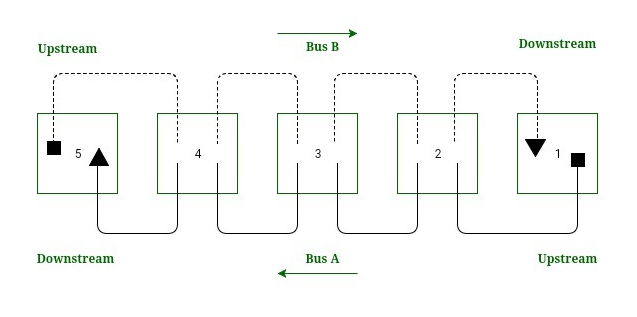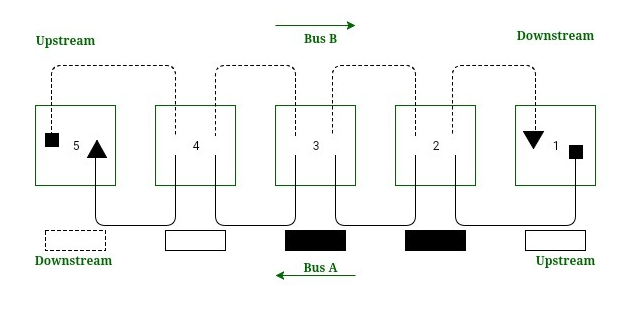
IEEE 802.6 standard i.e. DQDB(Distributed Queue Dual Bus) is a MAN(Metropolitan Area Network) protocol. It can be defined as a high speed shared medium access control protocol that is used over a bus network. It has two unidirectional buses, for controlling purposes, where the bus can carry data, video, and voice over a network with bandwidth being allocated as per time slots. The advantage of using the paired bus is that it is used to tackles failure configuration. It can be extended up to 30 miles at 34-55 Mbps.

Fig.1:- Working of DQDB
Directional Traffic:
Each bus support traffic in only one direction and are opposite to one another. The start of the bus being represented as a square and the end of the bus being represented as a triangle (Fig.1). Bus A traffic moves from right to left (i.e. from station 1 to 5) whereas the bus B traffic moves from left to right (i.e. from station 5 to 1).
Upstream and Downstream:
The relationship of stations of the DQDB network depends on the directional flow of traffic of the buses.
Considering bus A in Fig.1, which has station 1 & 2 marked as upstream w.r.t station 3 and station 4 & 5 are downstream w.r.t station 3. Here in bus A, station 1 is head of the bus as there is no upstream station and station 5 has no downstream station and it is regarded as to end of bus A.
Working:
The head of the bus A i.e. station 1 generates empty slot for use of bus A. Similarly, the head of bus B i.e. station 5 generate empty slot for use of bus B. The empty slot travels down its bus until the transmission station drops data into it and intended destination reads the data.

Fig.2:- DQDB Slot traveling
For example:
If station 2 wants to send data to station 4 (Fig.2), it chooses a slot on bus A as station 4 is downstream in bus A. The head of the bus A i.e. station 1 creates an empty slot. Station 2 drops its data & address of destination slot into the passing slot. Station 3 reads the address and passes the slot as unread. Station 4 recognizes its address, reads the data and changes the status of the slot and passes it along with station 5 where it is absorbed.
How slot reservation is done?
To send data downstream, a station must wait for the arrival of the unoccupied slot, but here the question arises that how to stop an upstream station from manipulating the bus due to which the station near the end of the bus suffers, as the imbalance can lead to degraded quality of service. The solution to this problem is to do a reservation at the station. Here station 2 can make a reservation for bus A on bus B. Station 2 sets a reservation bit on a slot on bus B to tell each station it passes through, that the station is reserving a slot on bus A. All the station must respect the reservation of downstream station and leave the slot for requested station.